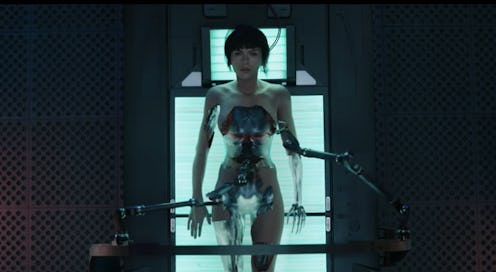
Ghost in the Shell is a bit of a throwback when it comes to movies that depict the future. Based on a manga that debuted in 1989, the new film keeps the original's cyberpunk 21st century setting — a seemingly outdated future that was frequently depicted in sci-fi films of the '80s and '90s. But despite its retro-future charm, Ghost in the Shell also features some pretty crazy tech — especially the concept of putting a human mind inside an artificial body. But could Ghost in the Shell really happen, or is the film's technology just another relic of its '80s vision of the future?
Believe it or not, there actually are many scientists today who are trying to figure out a way to upload human consciousness into machines. Their goal? Immortality. It sounds like science fiction, but it could come to pass — though probably not for a while. Neuroscientist Dr. Ken Hayworth believes he knows the key to figuring out how to do it: fully mapping all the neuron connections in the brain, known as the connectome. "In the same sense that my computer is really just the ones and zeros on my hard drive, and I don't care what happens as long as those ones and zeros make it to the next computer, it should be the same thing with me," Hayworth told BBC News in an interview last year. "I don't care if my connectome is implemented in this physical body or a computer simulation controlling a robotic body."
However, Hayworth doesn't anticipate that happening anytime soon, as the technology to do so doesn't exist yet. "We are pitifully far away from mapping a human connectome," he said. "To put it in perspective, to image a whole fly brain it is going to take us approximately one to two years. The idea of mapping a whole human brain with the existing technology that we have today is simply impossible."
Stephen Hawking, probably the most famous scientist today, also thinks it's plausible but a long ways off. "I think the brain is like a program in the mind, which is like a computer, so it's theoretically possible to copy the brain onto a computer and so provide a form of life after death," he said in 2013, according to The Telegraph. "However, this is way beyond out present capabilities."
Other scientists, however, think that the technology isn't that far off. Futurist and author Ray Kurzweil thinks human minds will be uploaded into computers by 2030. And Russian billionaire Dmitry Itskov has set a goal of 2045 for his aptly named 2045 Initiative, which doesn't just aim to upload human consciousness into robots, but has a vision of transforming the entire future of the human race. The below video, taken from their website, is like something straight out of a science fiction movie.
The 2045 Initiative is maybe a little too ambitious in its predictions, but the fact remains that a lot of money and research is being dumped into figuring out a way to upload the human mind into an artificial body — meaning we might see the world of Ghost in the Shell come to pass in our lifetime after all — though probably with less '80s fashion.